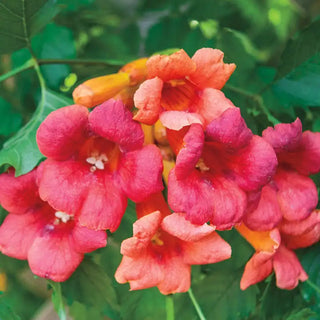Ready to take your garden to new heights? Fill in with flowering vines. Vines and climbers are perfect for decorating small planting areas, adding something special to planters, or covering walls, trellises, or porches. They can also be used in living privacy screens, climbing up fences or arbors. Or, allow your flowering vines to sprawl for ground cover. From climbing roses and jewel-toned clematis to rustic favorites like Major Wheeler Honeysuckle and bright trumpet vines, you'll find the right climbing vine for your garden here with Gurney's. Shop passion vine, climbing roses, clematis, climbing hydrangeas and much more.
Vine Plants and Flowering Climbers
What are vine plants and flowering climbers?
Vine plants are characterized by their long, flexible stems that either climb or trail along surfaces, often using tendrils or other structures for support. Flowering climbers, a specific type of vine, are especially popular in gardens and landscapes for their ability to add vertical interest and vibrant blooms as they grow.
How to grow vine plants
Growing vine plants requires careful planning, preparation, and ongoing care to ensure healthy growth and vibrant foliage or flowers. Here's a step-by-step guide:
Choose the Right Vine Plant:
Choose a vine plant that matches your climate, soil conditions, and the look you want to achieve. Popular options include clematis, wisteria, morning glories, and ivy. Decide whether you prefer a flowering vine, an evergreen variety, or one that bears fruit.
Select an Appropriate Location:
Most vine plants flourish in full sun, needing at least 6-8 hours of sunlight each day, although some, like ivy, can tolerate partial shade. It's important to select a spot with well-draining soil, as waterlogged conditions can cause root rot.
Prepare the Soil:
Before planting, enrich the soil with organic matter like compost or well-rotted manure to boost its fertility and drainage. Loosen the soil to a depth of 12-18 inches to ensure the roots have ample space to establish themselves properly.
Install a Support Structure:
Vine plants need a sturdy support system to climb, such as a trellis, fence, arbor, or pergola. The support system needs to be strong enough to bear the weight of the mature plant. For example, climbing vines that use tendrils or twining stems need a structure with thin, vertical elements they can grasp.Planting:
Dig a hole twice as wide as the plant's root ball and the same depth. Carefully place the vine in the hole, ensuring it sits at the same depth as in its nursery container. Backfill with soil, gently firming it around the roots.
Watering:
After planting, water the vine thoroughly. Vines typically require consistent moisture, particularly during the first year of establishing their root system. However, be careful not to overwater, as this can cause root rot.
Mulching:
Apply a layer of mulch around the base of the plant to retain moisture, suppress weeds, and regulate soil temperature. Mulch should be kept a few inches away from the stem to prevent rot.
Training and Pruning:
As the vine grows, guide it to climb the support structure by gently tying the stems with garden twine. Regular pruning is crucial for maintaining its shape, encouraging flowering, and removing dead or damaged growth. Prune in late winter or early spring, depending on the plant's specific needs.
Fertilizing:
Feed the vine plant with a balanced fertilizer during the growing season to promote healthy growth and flowering. Be cautious with nitrogen levels, as too much can lead to excessive foliage growth at the expense of blooms.
Pest and Disease Management:
Regularly check the plant for pests like aphids or signs of diseases such as powdery mildew. Address any problems quickly using suitable organic or chemical treatments.
For more information on growing vines visit our How to Grow Vines from Gurney's page.When to grow vine plants
The timing of planting vine plants is crucial to ensure they establish well and thrive:
Spring Planting:
- Best Time: After the last frost, early spring is ideal for planting most vine plants. The warming soil and increasing daylight encourage root growth, giving the plant an entire growing season to establish itself before the stress of summer heat.
- Advantages: Spring planting allows the vine to take advantage of the growing season, leading to a more robust establishment and better growth.
Fall Planting:
- Best Time: Early fall, when temperatures start to cool but the soil is still warm, is another good time to plant vines. Depending on your growing zone, be sure to plant your vine before the first frost.
- Advantages: Fall planting gives the vine time to develop roots without the stress of summer heat. The cooler weather reduces water stress, and the plant can establish a robust root system before winter dormancy. This leads to vigorous growth in the following spring.
Considerations:
- Climate: In regions with mild winters, fall planting may be more advantageous as the plant will be established during the cool, wet winter. Spring planting might be safer in colder climates to avoid winter damage to young roots.
- Plant Type: Some tender or tropical vines may require planting later in spring or early summer when the soil and air temperatures are consistently warm.
Avoid Planting in Harsh Conditions:
- Summer: Avoid planting in mid-summer when heat is high, and newly planted vines are more susceptible to drought and transplant shock.
- Winter: In cold climates, avoid planting in winter when the ground is frozen or too cold for root growth.






































